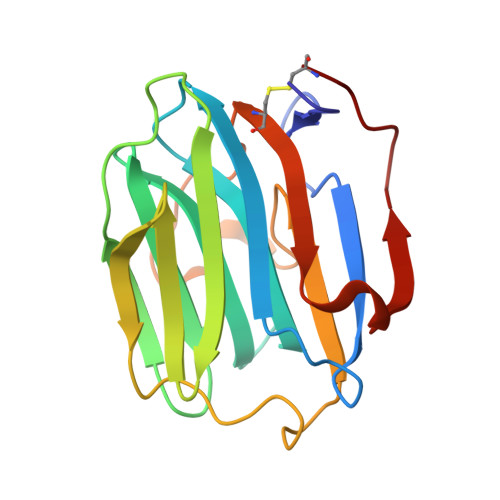Resolution of a disordered region at the entrance of the human sex hormone-binding globulin steroid-binding site.
Grishkovskaya, I., Avvakumov, G.V., Hammond, G.L., Muller, Y.A.(2002) J Mol Biol 318: 621-626
- PubMed: 12054810
- DOI: https://doi.org/10.1016/S0022-2836(02)00169-9
- Primary Citation of Related Structures:
1KDK, 1KDM - PubMed Abstract:
The crystal structure of human sex hormone-binding globulin (SHBG) has revealed how 5alpha-dihydrotestosterone intercalates between the two seven-stranded beta-sheets of its amino-terminal laminin G-like domain. However, a region of disorder (residues 130 to 135 of SHBG) was identified together with a zinc-binding site in immediate proximity to the steroid. It has been important to resolve the structure of this region because previous studies have suggested that these residues may contribute to steroid binding directly. Here, we present the 2.35 A and 1.7 A crystal structures of the amino-terminal LG domain of SHBG obtained from a tetragonal crystal form and by EDTA-soaking of a trigonal crystal form, respectively. In both of these new structures, residues Pro130 to Arg135 are now clearly visible. Substitution of the two residues (Leu131Gly and Lys134Ala) pointing towards the steroid has shown that only Leu131 contributes significantly to steroid binding. Rather than covering the steroid-binding pocket in an extended conformation, a 3(10) helical turn is formed by residues Leu131 to Lys134 in this segment. Unfolding of this secondary structure element can either facilitate the entry of the steroids into the binding site or modulate the important contribution that Leu131 makes to steroid binding. A comparison with previous structures supports the concept that zinc binding re-orients the side-chain of His136, and this residue serves as a lever causing disorder within the loop structure between Pro130 and Arg135.
Organizational Affiliation:
Forschungsgruppe Kristallographie, Max-Delbrück-Centrum für Molekulare Medizin, 13092 Berlin, Germany.















